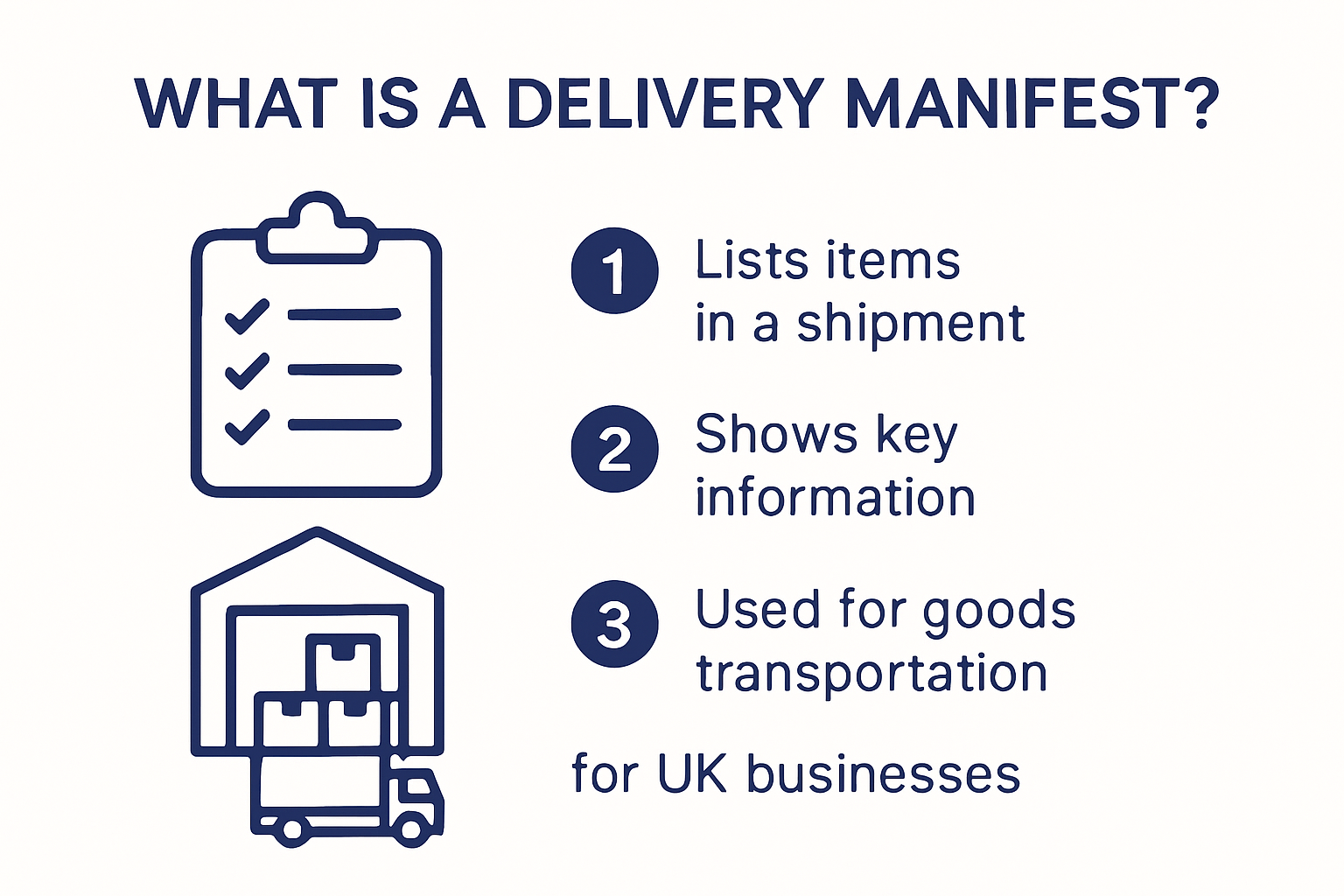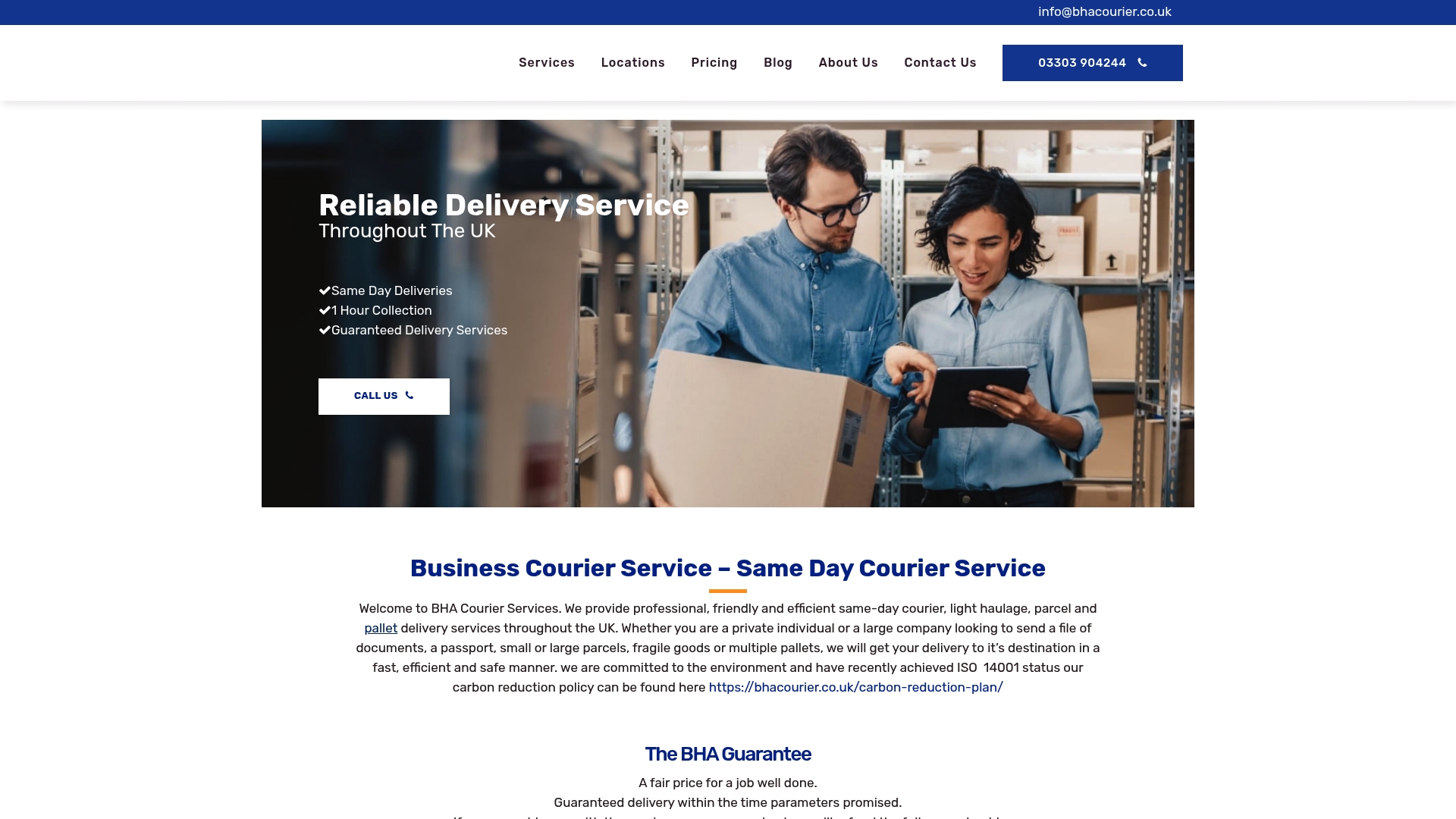
16 Jul What Is a Delivery Manifest? Guide for UK Businesses 2025

Every package moved in the UK must be accounted for with meticulous detail. Sounds straightforward. Yet, delivery manifests are now a legal necessity for shipments rather than a helpful extra, with fines for errors running into thousands of pounds. Most business owners still underestimate how a flawless manifest can make or break efficient shipping and even prevent costly disputes with customs. Here is where smart logistics truly start.
Table of Contents
- Understanding What A Delivery Manifest Is
- Key Benefits Of Delivery Manifests For Uk Businesses
- How To Prepare And Use A Delivery Manifest
- Delivery Manifest Vs Bill Of Lading Explained
Quick Summary
| Takeaway | Explanation |
|---|---|
| Comprehensive Document | A delivery manifest serves as a detailed inventory of goods being transported, ensuring transparency and accountability during shipping operations. |
| Regulatory Compliance | In the UK, delivery manifests are essential for meeting legal requirements and maintaining proper shipping records, aiding customs clearance and reducing legal risks. |
| Operational Efficiency | By implementing detailed delivery manifests, businesses can streamline logistics, enhance tracking capabilities, and reduce errors, ultimately improving resource management and cost efficiency. |
| Key Components for Preparation | Essential information for a delivery manifest includes consignor details, package identification, quantity, goods description, and destination information, all of which must be accurately maintained. |
| Distinction from Bill of Lading | Understanding the differences between a delivery manifest and a bill of lading is crucial for operational precision, as the former serves as an operational document while the latter holds legal significance in ownership and contractual obligations. |
Understanding What a Delivery Manifest Is
A delivery manifest is a critical document in the logistics and transportation industry that serves as a comprehensive record of goods being transported from one location to another. This essential paperwork provides a detailed inventory of all packages, parcels, and consignments loaded onto a delivery vehicle, ensuring transparency and accountability throughout the shipping process.

Key Components of a Delivery Manifest
A typical delivery manifest contains several crucial pieces of information that facilitate smooth transportation and tracking. According to gov.uk documentation, the manifest must include specific details about the shipment. These typically encompass:
- Consignor Details: Complete contact information of the sender
- Package Identification: Unique marks, numbers, and tracking codes
- Quantity and Type: Number of packages and their specific classifications
- Goods Description: Comprehensive details about the items being transported
- Destination Information: Complete delivery address and recipient contact details
To make it easier to visualise the key details required, the table below summarises the essential components of a delivery manifest and what each entails:
| Component | Description |
|---|---|
| Consignor Details | Contact info of the sender |
| Package Identification | Unique marks, tracking codes, and numbers |
| Quantity and Type | Number and classification of packages |
| Goods Description | Details about items being transported |
| Destination Information | Full address and contact of recipient |
Legal and Operational Significance
In the United Kingdom, delivery manifests play a crucial role in both operational logistics and regulatory compliance. HMRC guidelines specify that for goods exported in containers, the manifest must include the identifying number of the container and the names of the container operators. This requirement ensures complete traceability and helps customs authorities monitor international shipments effectively.
For businesses, a well-prepared delivery manifest offers multiple benefits. It provides a clear audit trail, supports accurate billing, enables precise tracking, and serves as a legal document that can be used in case of disputes or insurance claims. Professional courier services like BHA Courier use these manifests to guarantee transparency and accountability in their delivery processes.
The manifest goes beyond simple record keeping. It acts as a critical communication tool between various stakeholders in the transportation chain – from the initial sender to the final recipient, including logistics providers, warehouse managers, and customs officials. By documenting every detail of a shipment, businesses can streamline their supply chain operations and reduce the potential for errors or misunderstandings.
For UK businesses operating in an increasingly complex global marketplace, understanding and maintaining accurate delivery manifests is not just a regulatory requirement but a strategic necessity. These documents provide the foundation for efficient logistics, enabling companies to track shipments precisely, manage inventory effectively, and provide customers with real-time information about their deliveries.
Whether you’re a small e-commerce business shipping local packages or a large enterprise managing international consignments, mastering the intricacies of delivery manifests can significantly enhance your operational efficiency and customer satisfaction.
Key Benefits of Delivery Manifests for UK Businesses
Delivery manifests provide UK businesses with a powerful tool for optimising logistics operations, ensuring regulatory compliance, and enhancing overall supply chain performance. These comprehensive documents offer far more than simple record keeping, delivering strategic advantages that can transform business efficiency and customer satisfaction.
Enhanced Supply Chain Transparency and Tracking

In the complex world of modern logistics, visibility is paramount. Gov.uk research indicates that businesses leveraging detailed delivery manifests can capture critical data about customer information, delivery schedules, and compliance documentation. This comprehensive approach enables companies to:
- Monitor Real-Time Shipment Status: Track goods from origin to destination with unprecedented precision
- Identify Potential Bottlenecks: Quickly recognise and address logistical challenges
- Improve Inventory Management: Maintain accurate records of goods in transit
Operational Efficiency and Cost Management
Delivery manifests are not just administrative documents they are strategic tools for operational optimization. Project Delivery Guidelines highlight that systematic tracking through manifests can lead to significant improvements in resource allocation and cost reduction. By providing a detailed overview of each shipment, businesses can:
- Streamline routing and transportation planning
- Reduce administrative overhead
- Minimise errors and associated financial risks
Businesses looking to enhance their local delivery capabilities might want to explore our regional courier services for more targeted logistics solutions.
Compliance and Risk Management
In an increasingly regulated business environment, delivery manifests serve as a critical tool for maintaining legal and operational standards. Regulatory documentation emphasises the importance of comprehensive shipping records in meeting both domestic and international compliance requirements.
Key compliance benefits include:
- Detailed documentation for customs clearance
- Evidence of proper handling and transportation
- Protection against potential legal disputes
- Comprehensive audit trails for regulatory inspections
To summarise the main benefits for UK businesses, see the table below:
| Benefit Area | Key Advantages |
|---|---|
| Supply Chain Transparency | Real-time tracking, bottleneck identification, inventory accuracy |
| Operational Efficiency | Streamlined planning, reduced errors, lower costs |
| Compliance & Risk | Customs documentation, legal protection, audit facilitation |
For UK businesses navigating complex logistics landscapes, delivery manifests represent more than just paperwork. They are strategic assets that provide comprehensive insights, drive operational excellence, and support robust business growth. By investing time and resources in creating accurate and detailed manifests, companies can transform their logistics operations from a necessary expense to a competitive advantage.
Whether you’re a small e-commerce startup or an established enterprise managing complex supply chains, understanding and implementing effective delivery manifest practices can significantly enhance your operational efficiency, customer satisfaction, and bottom-line performance.
How to Prepare and Use a Delivery Manifest
Preparing an accurate and comprehensive delivery manifest is crucial for UK businesses seeking to streamline their logistics operations and ensure regulatory compliance. This process requires careful attention to detail and a systematic approach to documenting shipment information.
Essential Information for Manifest Preparation
According to Project Delivery Guidelines, a standard delivery manifest should include several critical metadata components. These typically encompass:
- Document Identification: Unique reference number, classification, and version
- Issuer Details: Complete contact information of the shipping company
- Date of Issue: Precise date the manifest is created
- Comprehensive Shipment Data: Detailed information about the goods being transported
Step-by-Step Manifest Creation Process
Government guidance for cargo reporting provides insight into the meticulous process of creating an accurate manifest. Businesses should follow these key steps:
-
Collect Shipment Details
- Gather complete information about each package
- Record precise package descriptions
- Note container identification numbers
- Verify gross weight of shipments
-
Verify and Cross-Check Information
- Confirm accuracy of sender and recipient details
- Validate package quantities and descriptions
- Ensure all required documentation is complete
-
Digital Documentation
- Use standardised digital templates
- Implement robust tracking systems
- Maintain secure digital records
Businesses looking to optimise their delivery processes might want to explore our specialised courier services for additional support.
For greater clarity, the following table breaks down the process of creating a delivery manifest into step-by-step actions:
| Step | Actions Involved |
|---|---|
| Collect Shipment Details | Gather package info, descriptions, container IDs, weight |
| Verify and Cross-Check Information | Confirm sender/recipient data, validate quantities, ensure documentation |
| Digital Documentation | Use standard templates, implement tracking, secure digital records |
Best Practices and Common Pitfalls
Successful manifest preparation requires more than just filling out a form. Key considerations include:
- Accuracy is Paramount: Even minor errors can cause significant shipping delays
- Consistency in Documentation: Maintain uniform recording standards
- Regular Updates: Keep manifest information current and reflective of actual shipment status
- Compliance Awareness: Stay informed about changing regulatory requirements
Many businesses struggle with manifest preparation due to complex logistics and regulatory landscapes. Common mistakes include incomplete package descriptions, incorrect weight measurements, and outdated contact information. Implementing a robust quality control process can help mitigate these risks.
For UK businesses, a well-prepared delivery manifest is more than administrative paperwork. It serves as a critical communication tool that ensures smooth transportation, supports accurate billing, and provides a clear audit trail for every shipment. By investing time in developing comprehensive and precise manifests, companies can significantly enhance their operational efficiency and reduce the potential for logistical complications.
Whether you’re managing local deliveries or handling international shipments, mastering the art of delivery manifest preparation can transform your logistics operations from a potential source of stress to a streamlined, reliable business process.
Delivery Manifest vs Bill of Lading Explained
In the complex world of logistics and international shipping, two critical documents often cause confusion for businesses: the delivery manifest and the bill of lading. While both play essential roles in transportation and documentation, they serve distinctly different purposes and carry unique legal and operational implications.
Defining the Documents
According to business.gov.uk, a Bill of Lading is a comprehensive legal document that serves multiple critical functions:
- Receipt of Goods: Confirms the carrier has received the specified goods
- Contract of Carriage: Outlines the terms of transportation
- Document of Title: Can be transferred, effectively transferring ownership of the goods
In contrast, gov.uk guidance describes a delivery manifest as a detailed cargo inventory that provides operational insights, including:
- Number and type of packages
- Package marks and identification numbers
- Description of goods
- Gross weight and volume
- Shipping container details
Legal and Operational Differences
Wikipedia’s transportation documentation research highlights the fundamental distinctions between these documents:
-
Purpose
- Bill of Lading: Legal ownership and contractual agreement
- Delivery Manifest: Operational tracking and regulatory compliance
-
Transferability
- Bill of Lading: Can be negotiated and transferred between parties
- Delivery Manifest: Primarily an internal operational document
-
Information Focus
- Bill of Lading: Emphasizes legal and ownership details
- Delivery Manifest: Concentrates on physical cargo specifics
Businesses seeking efficient logistics solutions might want to explore our specialised courier services for expert guidance.
To clarify the distinctions, the following table compares the characteristics of a Delivery Manifest versus a Bill of Lading:
| Feature | Delivery Manifest | Bill of Lading |
|---|---|---|
| Main Purpose | Operational tracking and compliance | Legal ownership and contract of carriage |
| Transferability | Not typically transferable | Negotiable/transferrable |
| Content Focus | Shipment details and inventory | Ownership, terms, and receipt |
| Document Role | Internal logistics record | Legal proof of contract and receipt |
Practical Implications for UK Businesses
Understanding the nuanced differences between these documents is crucial for smooth international and domestic shipping operations. While a bill of lading serves as a legally binding document that can be used for financial transactions and proves ownership, a delivery manifest provides the granular operational details necessary for logistics management.
For UK businesses engaged in shipping, maintaining accurate documentation is not just about compliance it’s about creating a transparent, efficient supply chain. The bill of lading protects financial interests, while the delivery manifest ensures operational precision.
Key considerations for businesses include:
- Ensuring complete and accurate information on both documents
- Understanding the legal weight of a bill of lading
- Using delivery manifests for internal logistics planning
- Maintaining meticulous records for potential audits or disputes
Whether you’re a small e-commerce retailer or a large international trading company, mastering these documentation nuances can significantly streamline your shipping processes, reduce potential risks, and enhance overall operational efficiency.
Ultimately, while a bill of lading and a delivery manifest might seem similar, they are complementary tools that serve different but equally important roles in the complex ecosystem of modern transportation and logistics.
Frequently Asked Questions
What is a delivery manifest?
A delivery manifest is a comprehensive document that serves as a detailed inventory of goods being transported, ensuring transparency and accountability during the shipping process.
Why is a delivery manifest important for UK businesses?
A delivery manifest is crucial for UK businesses as it ensures regulatory compliance, supports efficient logistics operations, and provides a clear audit trail for shipments, helping to mitigate risks and disputes.
What information is required on a delivery manifest?
A delivery manifest should include essential details such as consignor information, package identification, quantity and type of goods, a description of the items, and complete destination information.
How does a delivery manifest differ from a bill of lading?
While a delivery manifest is primarily an operational document that tracks shipments and ensures compliance, a bill of lading serves as a legal document that confirms receipt of goods and outlines the contract of carriage.
Simplify Delivery Manifests and Elevate Your Shipping Reliability
Struggling with the complexities of creating accurate delivery manifests and meeting strict legal requirements? Many UK businesses find that administrative errors, inconsistent records, or delays in documentation can lead to costly fines and shipment disruptions. If you want peace of mind knowing every consignment is fully compliant, traceable, and ready to move without a hiccup, now is the time to act. Partnering with a logistics expert who understands the importance of flawless paperwork and transparent tracking can make all the difference.

Choose BHA Courier to transform your delivery process. Our team not only ensures every parcel is managed with secure, same-day speed but also handles your manifests and documentation to the highest professional standards. Enjoy benefits such as nationwide rapid collection, dedicated parcel and document tracking, and seamless integration with your business needs. Want your logistics to run smoother and ensure you never miss a regulatory detail? Discover how we can help by visiting BHA Courier. Book your delivery today and experience the confidence of a fully accountable service.
Recommended
- Same Day Bristol Courier – Guaranteed – BHA Couriers
- Same Day Courier London – BHA Couriers
- Light Haulage Services – UK-Wide Delivery – BHA Couriers
- What Insurance Do Couriers Need? A Comprehensive Guide – BHA Couriers
- What Is International Shipping? Guide for UK Movers 2025 | Schott Removals
- Waste Management Definition for UK Businesses 2025 – Venture Waste

Sorry, the comment form is closed at this time.